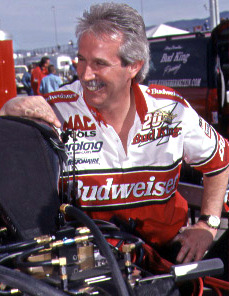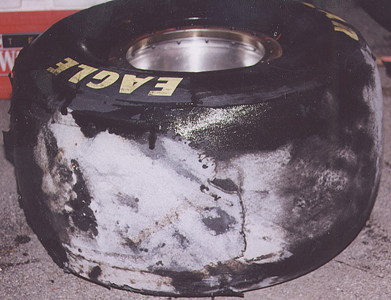 |
 At the recent NHRA Mopar Parts Nationals in Englishtown, N.J., and
the NHRA Prestone Nationals in Joliet, Ill., nitro racers ran into a very
thorny tire problem. The super-biting N.J. facility along with the very
cold climes combined to take chunks out of the rear slicks. Not the usual
thin strips of roughage one sees on a used slick, but bites out of the
edge of the tires. At the Joliet race, former two-time Winston champ Gary
Scelzi ran a 4.60/316.67 for low e.t. in qualifying, but before entering
the traps had a small chunk of the right rear slick fly out. This caused
the tire to get severely out of balance and it shook the car so violently
that it failed the rear-wing assembly. A bigger chunk ripped out of the
tire after the car rolled. We decided to consult an expert on nitro racing
and related subjects, Lee Beard, the crew chief of Kenny Bernstein's Bud
King Top Fuel dragster, and inquire in so many words, "What's the deal
with the rear tires on the fuel cars?"
At the recent NHRA Mopar Parts Nationals in Englishtown, N.J., and
the NHRA Prestone Nationals in Joliet, Ill., nitro racers ran into a very
thorny tire problem. The super-biting N.J. facility along with the very
cold climes combined to take chunks out of the rear slicks. Not the usual
thin strips of roughage one sees on a used slick, but bites out of the
edge of the tires. At the Joliet race, former two-time Winston champ Gary
Scelzi ran a 4.60/316.67 for low e.t. in qualifying, but before entering
the traps had a small chunk of the right rear slick fly out. This caused
the tire to get severely out of balance and it shook the car so violently
that it failed the rear-wing assembly. A bigger chunk ripped out of the
tire after the car rolled. We decided to consult an expert on nitro racing
and related subjects, Lee Beard, the crew chief of Kenny Bernstein's Bud
King Top Fuel dragster, and inquire in so many words, "What's the deal
with the rear tires on the fuel cars?"
 "After my conversations with Goodyear Tire engineers, the tire problem
can be traced to a number of things, but a lot of it to the 90-percent
nitro rule. We [Top Fuel and Funny Car] don't make as much horsepower
with that percentage and this causes the tires to stick better to the
race surface. It's easier to spin the tires on 100-percent than it is
90-percent and most fans over the years have probably seen numerous
fuel dragsters and funny cars spin their rear tires at well past half
track.
"After my conversations with Goodyear Tire engineers, the tire problem
can be traced to a number of things, but a lot of it to the 90-percent
nitro rule. We [Top Fuel and Funny Car] don't make as much horsepower
with that percentage and this causes the tires to stick better to the
race surface. It's easier to spin the tires on 100-percent than it is
90-percent and most fans over the years have probably seen numerous
fuel dragsters and funny cars spin their rear tires at well past half
track.
"However, since the tire is glued so well to the surface, the pull
against the tire from the surface and itself is greater. When the tire
spins, it dissipates heat and you can see that by the way the rubber
comes off the tire. When it's glued to the track, the tire gets the
full brunt of the heat; they get hotter when they're not spinning freely
and the effect is that chunks of the tire can come off.
"This isn't a hard and fast explanation because there are variables
in this situation. A person has to also take into consideration factors
like ambient temperature, track surfaces and other related items. For
example, everyone is still running the same type of Goodyear tires seen
at Joliet, and there were no problems or certainly not on the level
of Scelzi's crash. The reason was likely that the St. Louis [Sears Craftsman
Nationals] surface didn't bite as well as Joliet or at Englishtown.
There was more tire slippage there. However, at the really super traction
facilities, it's a different deal.
"In fuel racing, problems in all areas of a car can pop up. For example,
in 1997 at Sonoma [Autolite Nationals] Bruce Sarver and Eddie Hill both
had problems with exploding rear tires and you got all types of conjecture
as to what caused the blowouts. In that respect, the situation of pros,
cons and controversy are similar today's problem with the tires.
"I will say this. Reflexively, it's easy to get on Goodyear's case,
but these guys have been making racing slicks for 35-40 years; they
know what they're doing. They're are the only game in town when it comes
to Top Fuel and Funny Car and I know from experience that if there's
a problem, they're on it right away.
"To show what I mean, at Columbus [NHRA Pontiac Excitement Nationals]
a week after Joliet, Goodyear gave some teams what they call a 1230
tire made out of a rubber compound that has better adhesion. The rubber
tread sticks to the carcass better; the tire adheres to itself better
overall. Now that doesn't mean it'll have better traction; it might
have less. The new compound is also harder. But whatever, Goodyear was
on the job working to get the problem sorted out. Unfortunately, a lot
of teams, our team included, haven't been able to find time to test
it.
"In closing, problems creep up all the time in fuel racing. This tire
problem is just one and racing history has shown that it will be solved
soon enough."
|
|